
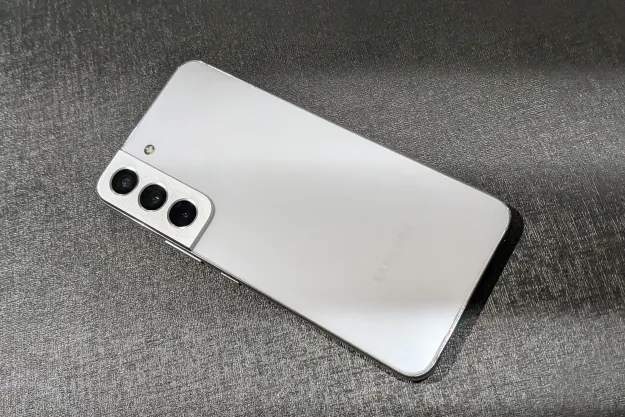
Samsung Galaxy S22
MSRP $799.00
“The Galaxy S22 is a fairly capable phone that should be on top of your Android phone buying list thanks to its handy build, top-notch performance, capable cameras, and long-term software update policy.”
Pros
- Pleasingly compact and sturdy build
- A gorgeous flat OLED screen
- Best-in-class Android OS upgrade policy
- Reliable cameras
- Fluid performance
Cons
- Small battery that drains quickly
- Charging speeds really need a boost
- Ultrawide camera has a distortion quirk
- Runs hot quickly under load
Editor’s note: The Samsung Galaxy S23 and Galaxy S23 Ultra are now official, so you may want to hold off …
Samsung Galaxy S22, the most affordable device in the company’s 2022 flagship series, has flown under the radar. The Korean electronics giant reserved all the fancy stuff for the Galaxy S22 Ultra, which also carries the heavy Note legacy on its shoulders. But that doesn’t mean the vanilla Galaxy S22 deserves to live in its shadow. In fact, this is one unassuming phone that hits heavier than its weight. Here’s the nitty-gritty about the phone before you decide to give Samsung a few hundred dollars from your wallet.
Design and build quality
The Galaxy S22 hasn’t seen anything in terms of aesthetic refinements. For folks coming from the Galaxy S21, Samsung’s latest flagship looks plain boring given the virtually indistinguishable design. But put it against any other flagship phone out there, and the Galaxy S22 will hold its own.
The Phantom White trim that we have for review is quite stunning, thanks to the pearly white rear panel that provides a subtle contrast against the metallic luster on the rails and camera island. The phone is also up for grabs in a stunning phantom black shade, alongside green and sand pink colors. But it’s the white that really exudes a distinct aura of a premium device with a minimalist appeal.
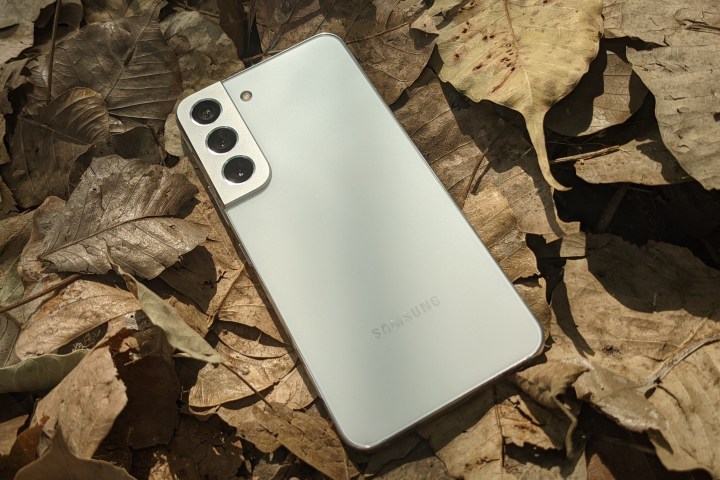
But it’s not just about the looks. The build quality is top-notch as well. Samsung has eschewed the Galaxy S21’s plastic rear panel in favor of a glass sheet that is protected by a layer of Gorilla Glass Victus on top. After having used the device for over three weeks without any protective cover, I couldn’t find any scuff marks on the rear panel. However, the display was another story. After a few days of use, it had visible signs of minor scraping all across.
The Galaxy S22’s display is another beautiful sight, with uniformly thin bezels on all sides. It looks gorgeous and puts the notch-loving iPhones to shame. The power and volume buttons offer a satisfactory click and are placed comfortably within reach. Of course, it helps that the Galaxy S22’s form factor is refreshingly compact and tips the scales at just 167 grams.
Packing a 6.1-inch screen, the Galaxy S22 is not exactly small. But compared to the beefy Max and Ultra class phones out there, the Galaxy S22 presents itself as one of those rare phones that won’t stretch your palms or fingers too much. Falling in the same size territory as the Pixel 4a and iPhone 14, the Galaxy S22 offers an unbeatable mix of terrific in-hand feel and pocketable size.
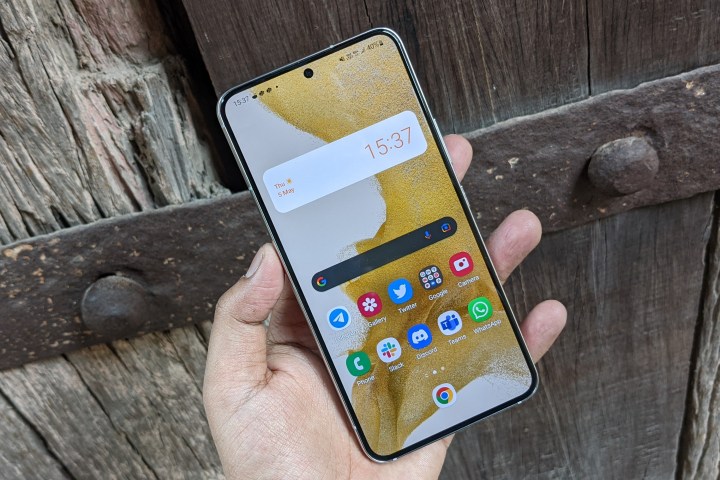
Samsung has also switched to using an X-axis haptic motor for its latest flagship. The vibration feedback is smoother and evenly distributed throughout the whole body, but the intensity has taken a hit. Comparing it against the Galaxy S21, there is a tangible difference, but it’s a subjective debate. Some users prefer a stronger and localized vibration feedback, while others prefer a softer but more uniform haptic response. Personally, I prefer the Galaxy S22 in this instance.
Samsung has also made a few compromises to achieve that relatively compact form factor. The 3.5mm headphone jack is again a no-show, as is the microSD card slot for storage expansion. And yes, the camera bump still makes the phone wobble when it’s lying on a flat surface.
Camera
Samsung has armed the Galaxy S22 with an upgraded 50-megapixel main camera, assisted by a 12-megapixel ultrawide snapper, and a 10-megapixel telephoto camera with 3x optical zoom output. Selfie duties are handled by a 10-megapixel main camera. To put it simply, these cameras mean business.
The main camera produces crisp pictures with impressive colors, tight contrast, plenty of details, and sharpness. Samsung has apparently tweaked the color chemistry this year, as the “Signature Samsung Saturation” has been toned down significantly. Colors are a lot closer to the real shades of an object, and far from the oversaturated mess of older Samsung phones. Surface details are retained well and subject separation is also on point.
I was particularly dazzled by the portrait mode. The camera did an impressive job at edge detection and rendered a nice depth of field effect. Even the studio lightning effects for portrait shots turned out to be in the same league as the iPhones. Moreover, the telephoto camera also did an impressive job capturing portrait shots.
The ultrawide camera was no different, retaining color uniformity against scenes captured by the main camera. However, one area where it faltered was the warping, especially with linear elements in the image. Take a look at the indoor shot clicked by the Galaxy S22 and its Ultra variant (below), both of which employ the same ultrawide camera hardware, but only one has that weird warping effect around the edges. Despite being sharp and well-exposed, the ultrawide photo taken with the S22 looks as if its angular symmetry has been crushed.

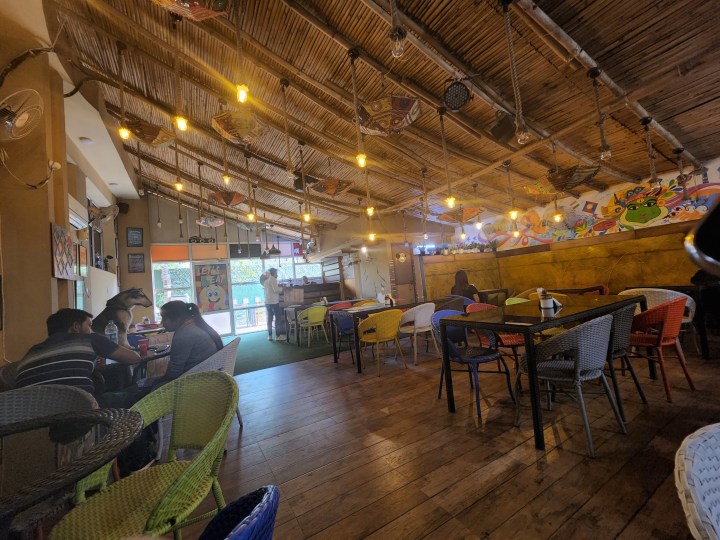
There is no macro camera here, but the main camera takes some stunning close-up photos. If you want to go closer, the telephoto camera is your friend. The zoom camera does a commendable job at macro photography. Just make sure that you have really stable hands or the phone is rested against fixed support, because the focus lock gets finicky at close range.
It’s great to see that Samsung has ported night mode support for all three cameras, but it’s the 50-megapixel main snapper that brings the best out of this lowlight photography trick. The main camera succeeds at discerning objects in the frame, even in extremely dark scenarios, and brought out colors with a healthy accuracy.
The ultrawide camera takes a couple of seconds longer to capture night mode shots, but the results are not as dramatic as those captured by the main camera. The 3x telephoto camera goes a little too aggressive at boosting the contrast, which also results in a more grainy picture at the cost of illumination. On the positive side, the surface textures appear more legible.
Of course, Samsung has also baked in a smorgasbord of camera tricks such as Single Take, portrait video, Director’s View, and Super Slow-Mo, among others. Director’s view lets you capture a scene from both the front and back, offering the convenience of using all three rear cameras.
The 10-megapixel selfie camera also does an acceptable job, but compared to the rear cameras, it has a tendency to lighten the skin tone and boost the saturation even without any filters. However, some users actually prefer the more punchy looks of their self-portraits that are tailor-made for social media.
Night mode selfies are well-executed when it comes to exposing more details and colors, but they are a tad noisier and softer compared to lowlight shots clicked by the rear cameras. The difference can be stark in some scenarios, as shown in the samples below:

Coming to video capture, they are plenty of options, both in terms of frame rate and resolution that goes all the way up to 8K. However, I found 1080p at 60 frames per second (fps) to be the sweet spot in terms of color accuracy and stabilization. I had some fun with super slow-motion mode, which produced some impressive clips in daylight, but low-ight and indoor scenarios still result in a banding effect in such videos.
Overall, the Galaxy S22 has a very capable set of cameras that is right up there against the iPhone 13, except for the latter’s more impressive videography chops. However, the Galaxy S22 offers the added versatility of a 3x telephoto camera that produces good results in both long-range and close encounters.
Screen
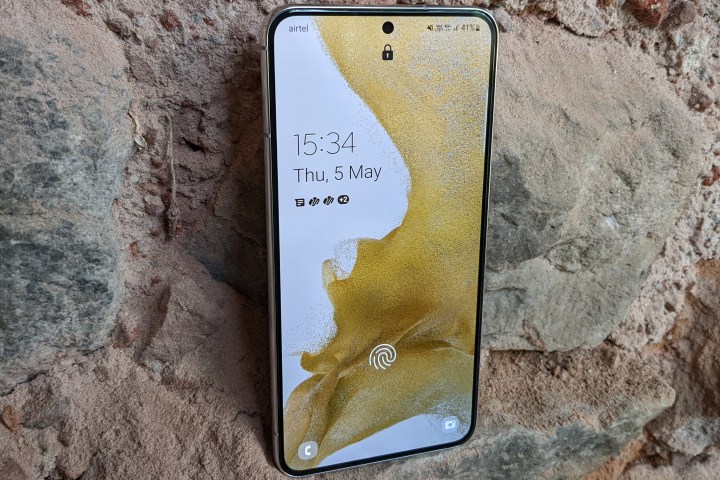
Samsung has armed the Galaxy S22 with a 6.1-inch HDR10+ Super AMOLED display with an FHD+ (2340 x 1080 pixels) resolution and 120Hz refresh rate. Now, there’s a key difference in the underlying high refresh rate technology employed by Samsung on the Galaxy S22 Ultra and the vanilla Galaxy S22.
While both the phones can hit a peak of 120Hz, the Galaxy S22 can only drop to a minimum of 48Hz, while the LTPO tech at the heart of the Ultra sibling allows the screen refresh rate to go as low as 1Hz depending on the on-screen content, saving some battery juice in the process.
After some initial confusion, Samsung revised the specs sheet and clarified that the Galaxy S22’s screen refresh rate can fall as low as 48Hz. But that, too, appears to be an inaccurate estimation. I enabled the native screen refresh rate overlay to check the values when the phone is sitting idle and noticed that the refresh rate dropped to a stable 24Hz. Even in the YouTube app, the refresh rate dropped as low as 24Hz, while other UI interactions happened at 120Hz.

But that is not to take anything away from the standard Galaxy S22. In fact, the entry-level Samsung flagship offers one of the most beautiful screens on a high-end Android phone. Viewing angles are great, sunlight legibility is also impressive, and colors simply pop out. The Natural preset in display mode retains the true colors, but it’s the slight bump in saturation offered by the Vivid mode that really brings out the best of this screen.
I compared the Galaxy S22 against the Galaxy S22 Ultra on a few synthetic tests for banding, contrast, viewing angle, and saturation. The vanilla Galaxy S22 held its own against the Ultra version on all counts, and only slightly lost edge when comparing contrast blocks in the lighter regions of the color scale.
Surprisingly, the standard Galaxy S22 fared better than the Ultra variant’s screen (image below) in the backlight control testing for rendering grayscale blocks against a dark background. Another difference is that the Galaxy S22’s display is slightly colder with a bluish tinge, while the S22 Ultra prefers warmer color chemistry with more aggressive auto-brightness controls.
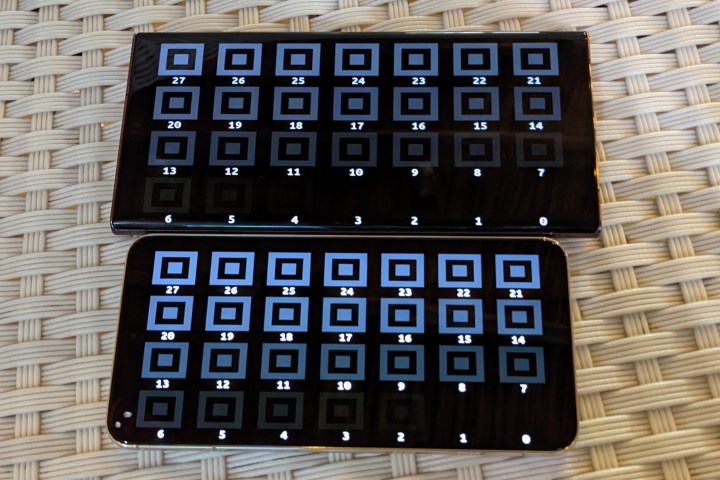
The deep blacks offered by the AMOLED panel shine when Dark Mode is enabled. Over the course of using the device, I didn’t feel the need to crank up the brightness to consume content, even under direct sunlight. Watching HDR content was a joy on the screen. But do keep in mind that only HDR10+ and HDR HLG support is available, and not Dolby Vision.
Software
The Galaxy S22 tested for our review runs One UI 4.1 based on Android 12 with the May security patch on top. The looks are familiar, but the support for Android 12’s Material You theming is a fresh aesthetic perk. Based on your wallpaper, icons in the notifications shade and other native UI elements adjust their color accordingly, with some pleasant transparency effects in tow.
The experience is quite refined though, and there are a ton of helpful features that are missing on stock Android. One UI 4.1 wasn’t much of a functional upgrade, but it introduced a handful of new features such as Smart Calendar, which automatically recognizes dates and times in messages and suggests them as calendar entries.
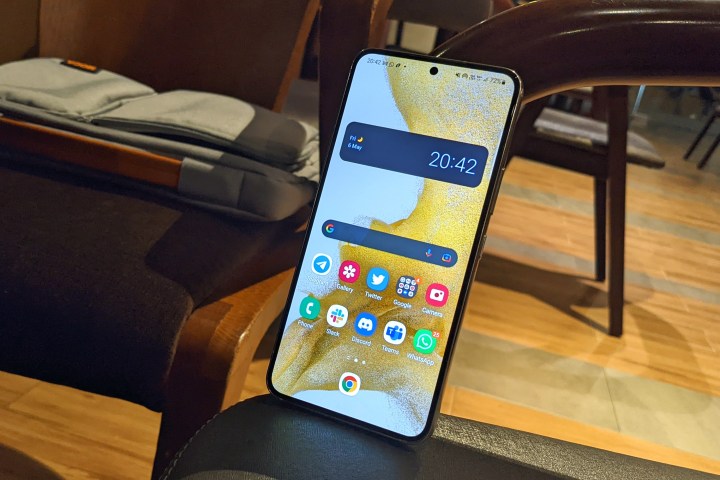
Samsung Pay has also been beefed up, as it can now store driver’s licenses (availability may vary), car keys, and movie tickets among other things. There’s also a new extra brightness toggle that lets users crank up the brightness if they deem it less than perfect. However, the auto-brightness system needs to be disabled for it to work. Widget stacking is another new feature that saves precious screen real estate and works flawlessly.
The Edge panel has also been refined and offers a ton of handy tools such as selecting and saving a portion of the on-screen content without having to fiddle with the editing controls in the Gallery app. I particularly loved using the native GIF maker tool, which turns a selected portion of the on-screen activity into a GIF almost instantly.
But the biggest advantage of buying the Galaxy S22 is Samsung’s promise of delivering four years of Android OS upgrades and five years of security updates at a quarterly or half-yearly cadence. That’s a year more than what Google promises for its own Pixel smartphones, and a fair bit higher than what rival Android smartphone makers from China have to offer.
Performance
The Galaxy S22 comes in two flavors – one with Qualcomm’s new Snapdragon 8 Gen 1 system on a chip and the other packing the in-house Exynos 2200 processor. Our review unit was the Qualcomm variant, but irrespective of the chip inside, performance across both units is at the summit.
The phone breezed past every task I threw at it. I tried some of the most demanding games out there with the graphics settings maxed out, and the phone handled it with ease. The system on a chip does its job just as well as one would expect from flagship silicon, but the Galaxy S22’s compact size also means space is extremely constrained under the hood, and that takes a toll on the thermal performance here.
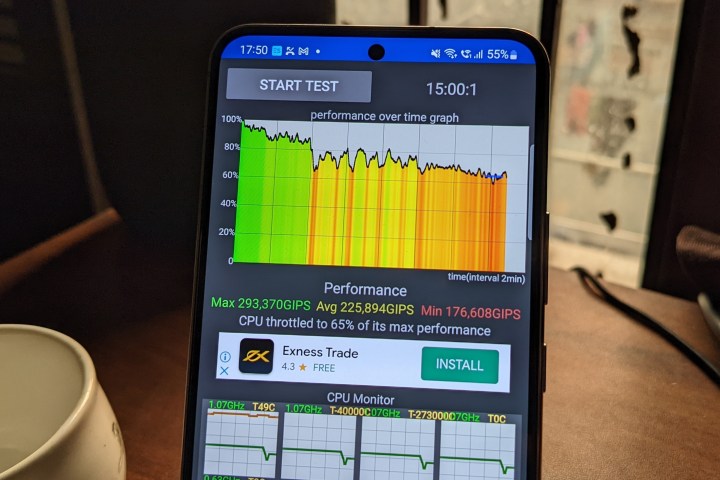
The processor performs ably, but the heat it produces eventually chokes the performance. Just take a look at the performance graph above and how it downgrades within 15 minutes of putting it through a synthetic stress test.
The relatively inferior thermal hardware also affects the Galaxy S22’s benchmark performance when compared to the Galaxy S22 Ultra, which reached a multi-core tally of 3106 on Geekbench, while its smaller sibling could only manage a score of 2932 in our tests.
I noticed that the shutter button occasionally became unresponsive after taking a lot of photos or capturing high-resolution videos. Frame drops and jitters were also noticeable after playing Call of Duty: Mobile at peak graphics settings for about 40 minutes.
Be it demanding games or intensive camera usage, the Galaxy S22 also gets hot pretty quickly, especially in the upper region. The metallic frame also doesn’t help with blocking the heat generated by the innards. However, the phone never sent a warning message for killing an app due to high temperatures.
Battery and charging

The battery situation is on a downhill trajectory with the Galaxy S22. Samsung has shaved 300mAh worth of ion juice from its predecessor, leaving the Galaxy S22 with a relatively small 3,700mAh unit. That’s one of the smallest batteries you’ll find in a modern smartphone launched after 2021, save for the iPhone mini line. And it actually makes a tangible difference in day-to-day use.
I remained connected to the internet throughout the day, heavily surfed social media, used at least five communication apps, watched a few YouTube videos, and listened to music for about three hours each day over Bluetooth headphones. Even without any gaming whatsoever, the phone barely went past a day.
On days that I had a few video calls, the battery emptied while on the commute back home. But the numbers will vary based on your usage scenarios. I got anywhere between 4and 5 hours of screen time, which is not the best figure I’ve seen on a flagship phone, even the smaller ones. However, if your phone usage is less demanding and you have cultivated a habit of plugging in your phone as soon as work hours are over, the Galaxy S22 shouldn’t sound any alarms.
Speaking of charging, there’s no charger in the box. Samsung sells the 25-watt charger separately, which is also the peak wired charging speed the phone has to offer. Again, it’s not the best, as the competition has already touched the 120W mark at a lower price. Depending on your carrier or preferred retail shopping outlet, you just might get the 25W charger as a freebie.
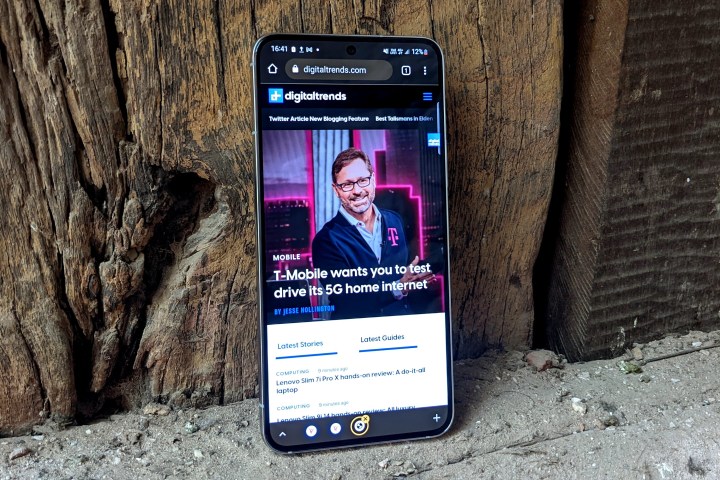
The charger takes half an hour to fill the empty tank up to 60%, while a full charge usually took an hour when the phone is not in use. Wireless charging support is also on the table at a peak wattage of 15W. I didn’t notice any heating issues while juicing up the phone on a wireless charging mat.
While playing Call of Duty: Mobile at peak graphics settings, the phone lost about 10 percent battery juice while the CPU temperature went up by 8 degrees Celcius during a 20-minute session. The game booster dashboard allows some degree of system-level optimization between performance and temperature monitoring, but it doesn’t make too much of a difference.
What really bothered me was the idle battery loss. Even when the phone was lying on a table with cellular internet enabled and communication apps running in the background, the phone lost nearly 10% to15% of the battery within a couple of hours. And that’s with the Adaptive Refresh rate tech enabled. The May update somewhat slowed the idle battery loss, but it’s still there.
Price and availability
The Galaxy S22 currently starts at $799 on Amazon and is $600 with new activation at Best Buy, while Samsung’s official website will take as much as $660 off if you exchange an eligible device. Carriers are also have some aggressive offers that are definitely worth checking out if you don’t want to switch lines.
If you pay the full amount at once for an unlocked unit, the 128GB variant of the Galaxy S22 can be yours for just $675 from the Samsung store, while the 256GB version will cost you $725. Aside from the usual Phantom Black, Phantom White, green and Pink Gold, the Samsung store also has four exclusive color options: Graphite, Cream, Sky Blue, and violet.
Our take
The headline says it all — the Galaxy S22 is boringly good. It comes equipped with all the fundamental traits of a pure Android flagship. For its price, the Galaxy S22 offers reliable cameras with a neat set of cool features, a fast processor, excellent build quality and in-hand feel, and an unparalleled software update policy in the Android ecosystem.
There are a few blemished though. The battery could be bigger with quicker charging speeds and the thermal management is not the best out there. But the more important question is how it measures up to rival phones. Both the iPhone 13 and the Google Pixel 6 undercut the Samsung flagship by a healthy $100 or more, and offer polished software married to top-notch hardware, reliable cameras, and more importantly, much better battery life figures.
But Samsung is trying to make up for it with aggressive offers. There are retail outlets that are bundling the charger for free with the Galaxy S22 and Samsung itself is handing over a handsome exchange bonus.
How long will it last?
The Galaxy S22 is built to last, which is evidenced by the fact that it’s set to receive software updates for the next five years. Samsung has used top-notch materials such as Gorilla Glass Victus and sturdy aluminum to create an IP68-certified phone. In a nutshell, it can handle a swim in the pool or a few drops from the table. With four assured OS upgrades, the phone will keep adding new features and won’t skimp on the security aspect either. On the longevity aspect, the Galaxy S22 almost matches Apple’s venerable iPhones.
What are the alternatives?
The most obvious competitor is the Google Pixel 6, which starts at $600 and offers dependable cameras and polished software in a neatly designed package. Over in Apple’s ecosystem, the iPhone 13 retails at the same price as its Samsung rival. With the iPhone 13, you get a pair of solid cameras, a secure iOS ecosystem with long-term software support, and much better battery life figures.
Should you buy it?
On its own, the Galaxy S22 is a terrific value-for-money smartphone. For Android loyalists hoping to steer clear of the Pixel 6’s buggy reputation, Samsung’s phone is undoubtedly the best option. If you’re gravitating toward the iPhone 13, the Galaxy S22 leapfrogs it with an extra telephoto camera, faster charging, a more modern design, and a less restrictive operating system. So, here’s the final verdict: If you are in the market for an Android phone with clean looks, good cameras, and feature-rich software, but don’t want to shell out over a thousand dollars, the Galaxy S22 is your best bet.
Editors’ Recommendations




